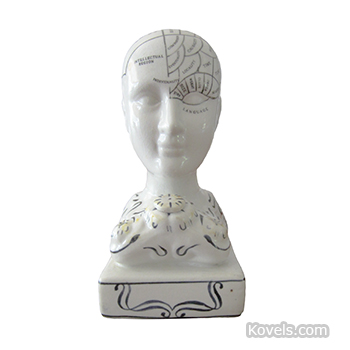Phrenology is the belief that human behavior is linked to the shape of a person’s head. It was first introduced by the Austrian physician, Franz Joseph Gall, in the late 1790s. According to Gall, when you use a certain part of your brain it grows larger (like a muscle) making a measurable “bump” on the skull, or gets smaller if unused, causing a dent in the skull. By feeling or observing the bumps and indentations, a patient’s brain and patterns of behavior could be studied.
During the height of phrenology in the 1830s, 3-D ceramic heads, some with inkwells added, were covered with “maps” illustrating 35 areas of the brain that indicated a human characteristic like memory, individuality, parental love, acquisitiveness, combativeness, friendship, mirthfulness, secretiveness, self-esteem, hope, as well as others. The best known manufacturer of ceramic phrenology busts was Lorenzo N. Fowler of London and New York. These original heads sell for $250 to $3,000. Reproductions sell for about $25 to $40.
Real or fake?
Reproduction phrenology busts may have a large hole in the base. Originals have tiny air holes in the flat bottom. Originals also usually have some crazing, but it rarely covers the entire bust. Fakes will often have crazing all over to create a look of age. Many reproductions are marked “L.N. Fowler” as well as “London,” but don’t be fooled. These were made in China and Japan during the 1960s and ʼ70s.





Leave a Reply
You must be logged in to post a comment.